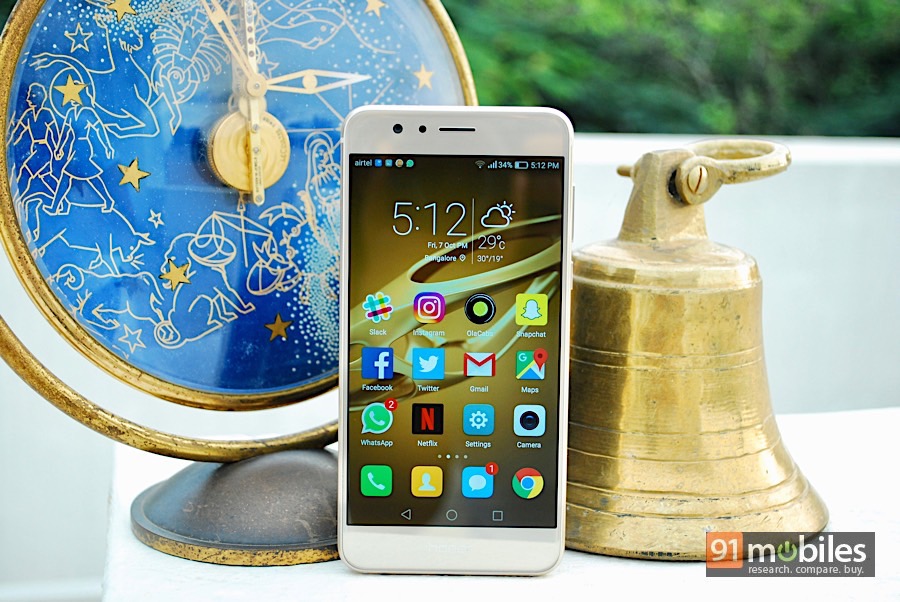
Indian consumers have a lot to choose from when it comes to a flagship smartphone, with key devices from practically every major brand available here. Among the most innovative flagships launched this year was the Huawei P9 (review), which caught our collective attention with its Leica-branded dual camera setup. For users intrigued by this feature, Huawei has a more affordable offering in the form of its sub-brand’s Honor 8. Like its better endowed sibling, the Honor 8 also boasts dual rear cameras (minus the Leica branding), and brings with it some very commendable specifications and a build quality that puts even more expensive flagships to shame. But can the smartphone testify to its prowess, or is it merely a watered down variant of the P9? We’ve had the phone in our labs for a while now, and here’s the low down.
Table of Contents
Specs at a glance
| Display | |
| Size | 5.2 Inch |
| Resolution | Full HD (1080 x 1920 pixels) |
| Performance | |
| CPU | Quad core, 2.3 GHz + Quad core, 1.8 GHz, HiSilicon Kirin |
| RAM | 4 GB |
| Storage | |
| Internal memory | 32 GB |
| External memory | Up to 128 GB |
| Battery | |
| Capacity | 3000 mAH, Li-Polymer, Non removable |
| Talktime | Up to 17.5 Hours (3G) |
| Standby Time | Up to 380 Hours (3G) |
| Camera | |
| Primary camera | 12 MP |
| Secondary camera | 8 MP |
| Connectivity | |
| Network support | Single SIM 4G |
| Other options | Wi-Fi, Bluetooth 4.2, GPS |
| Others | |
| Battery Capacity | 3000 |
| Operating system | Android 6.0 Marshmallow |
Design: a head-turner
Dimensions: 145.5 x 71.0 x 7.4 mmWeight: 153 grams
Dimensions: 145.5 x 71.0 x 7.4 mm Weight: 153 grams |
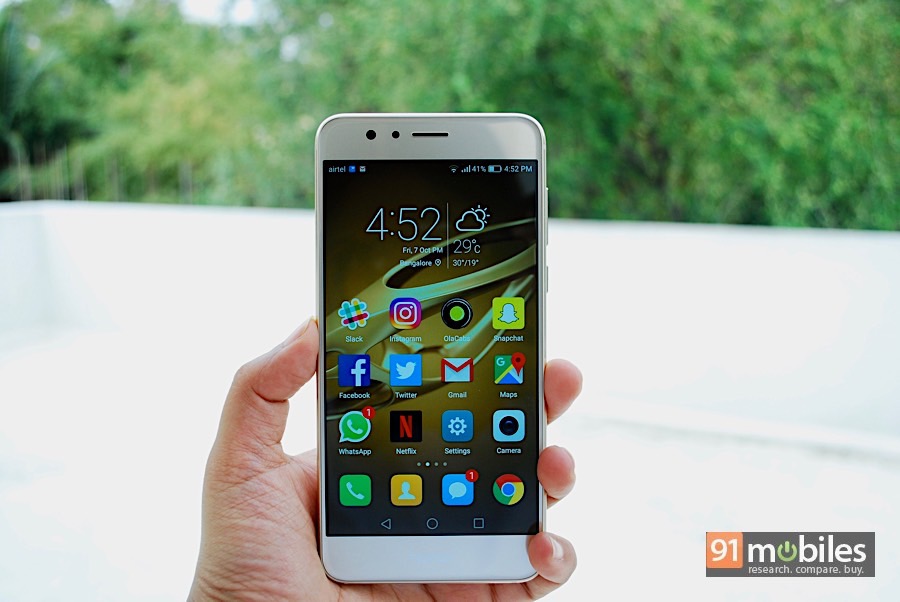
The Honor 8 is a work of art. It’s one of the most gorgeous phones we’ve seen this year, with a lightweight aluminium frame sandwiched between two layers of 2.5D curved glass. Our gold unit was a real stunner, but if we had to pick a favourite, it would be the Sapphire Blue. The mirror finish on the rear looks stunning, and the gold accents on the smartphone add several notches to its sex appeal. Unfortunately, both the front and rear don’t come with any sort of protection, and tend to pick up scratches. They’re also very prone to fingerprints and smudges, so you’d need to put a case on this phone, or be very careful with it. On the plus side, the Honor 8 isn’t as slippery as other glass sandwich smartphones like the OnePlus X and ASUS ZenFone 3.
The front of the smartphone features ample sized bezels at the top and bottom, but they slim down considerably along the sides. Above the screen is the usual arrangement of the earpiece, front camera and sensors. An invisible multicolour notification LED sits inside the earpiece, and you won’t notice it until it lights up. Below the screen you have only Honor branding, with the Android navigation keys appearing as software overlays on the display. Along the edges, you’ll find the volume rocker and power button on the right, a USB Type-C port, 3.5mm audio jack, microphone and loudspeaker at the bottom, and a secondary microphone and IR blaster at the top. The left spine is home to an ejectable tray, which features a single nano-SIM card slot and a microSD card slot. Honor has decided to launch only the single-SIM variant of the Honor 8 in India, which is very disappointing.
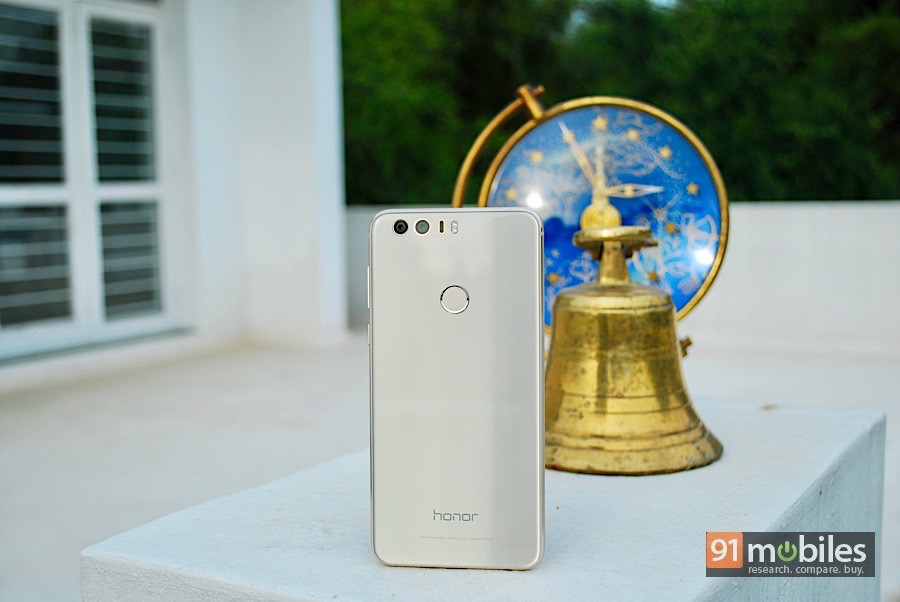
The back panel is devoid of any antenna lines, and features Honor branding and certification information at the bottom. Towards the top, you’ll find the two rear cameras which sit flush with the rear, flanked by a laser autofocus sensor and dual-tone LED flash. Underneath it lies the fingerprint sensor, which is both capacitive and physical. You can touch it to unlock the smartphone to sleep, but you can also press it to perform a variety of actions, which we’ll get to later.
With its rounded edges, compact size and light build, the Honor 8 is also very comfortable to use for long periods. We’re giving the brand a big thumbs up for this one.
Display: edge to edge
Size: 5.2 InchResolution: Full HD (1080 x 1920 pixels)Display Type: IPS LCDPixel Density: 424 ppi
Size: 5.2 Inch Resolution: Full HD (1080 x 1920 pixels) Display Type: IPS LCD Pixel Density: 424 ppi |
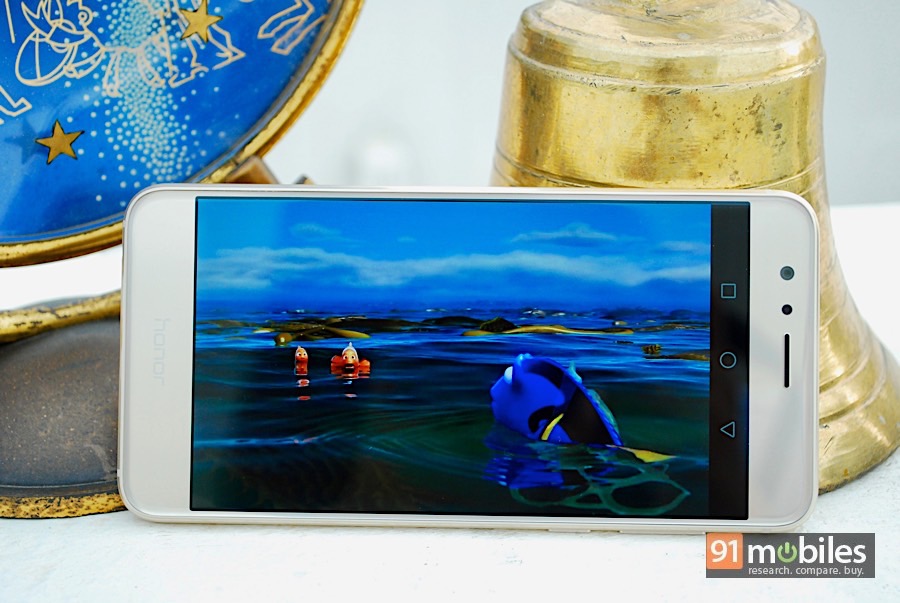
The Honor 8 features a 5.2-inch display with full HD resolution, making it plenty sharp at 423ppi. The 2.5D glass adds a lot to the design, but it tends to activate the display quite easily while holding the phone, which is a turn off. Colours, icons and text look crisp on the screen, and the contrast levels are good as well. We found that the auto-brightness was a bit glitchy, and often didn’t crank up the brightness enough.
In the display settings you can adjust the colour temperature to your liking, and also enable an Eye Comfort mode to cut out the blue light and reduce eye strain. There’s a Glove mode under the smart assistance section in settings if you want increased sensitivity.
Software: EMUI with a few extras
Operating System: AndroidOS Version: 6.0, Marshmallow
Operating System: Android OS Version: 6.0, Marshmallow |
The Honor 8 runs Android Marshmallow with EMUI 4.1 on top, the same version we saw on the Huawei P9. You get the usual EMUI tweaks like the Magazine Unlock lockscreen, integrated app drawer and homescreen, theme support (no downloadable themes on our unit) and more. Our Honor 8 unit didn’t come with any third-party apps, but given that we have a pre-production unit, it’s likely that the retail devices will have some extras installed, as was the case with the P9. The Honor 8 also comes with the Health app, which tracks your daily step count and lets you tag activities like walking, running and cycling.
The Smart Assistance section in settings lets you change the layout of the navigation bar, enable a floating dock, turn on some motion control gestures and enable a one-handed UI. The Honor 8 gets an interesting feature called Smart Screenshot, which lets you use your knuckles to take a variety of screenshots. You can tap twice with one knuckle to take a screenshot, or just use your knuckle to draw an out area of the screen you want to take a screenshot of. You can use your knuckle to draw an S for a scrolling screenshot as well. Tapping twice with two knuckles will begin a screen recording.
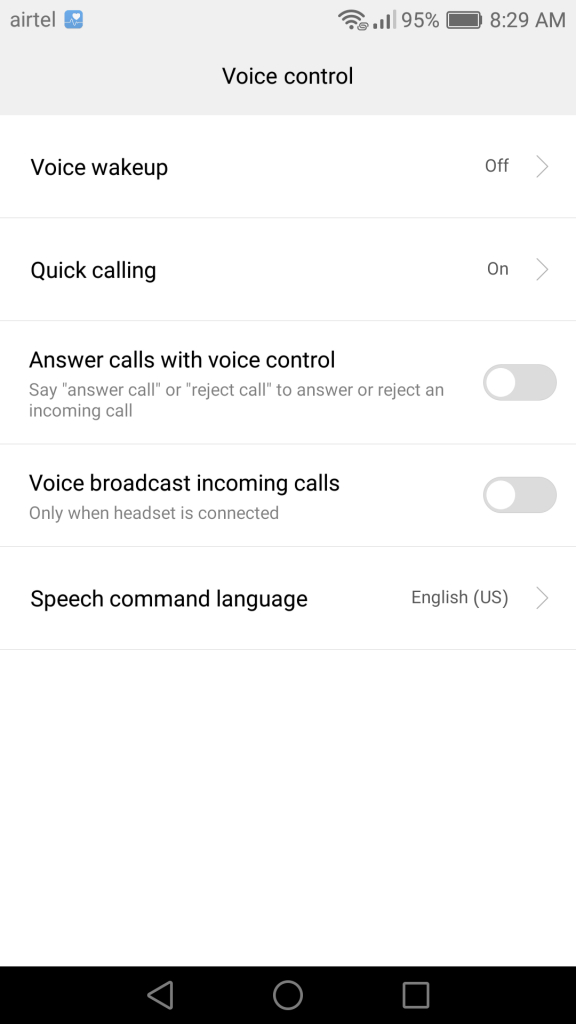
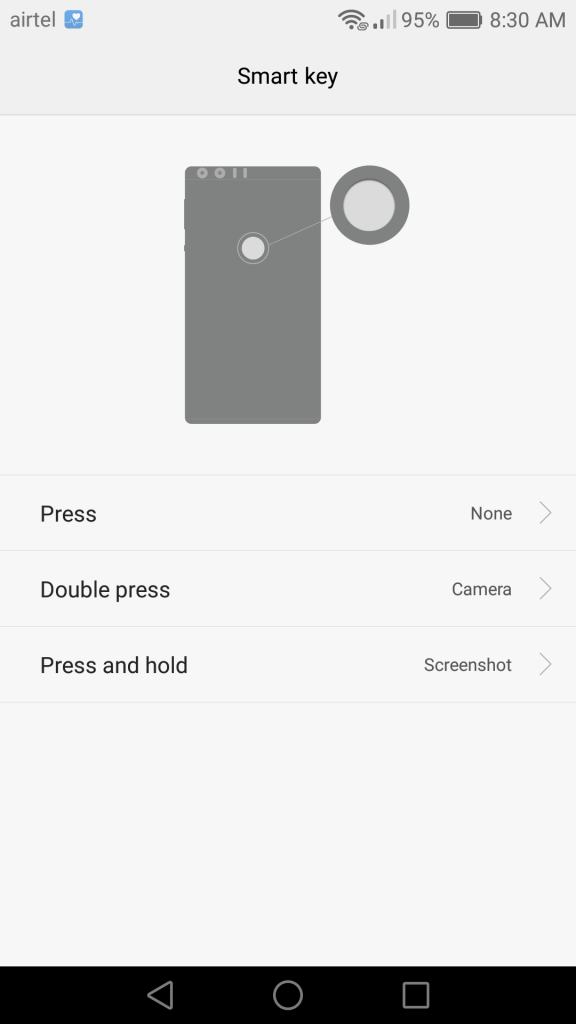
The Honor 8 also has some voice control features, which we earlier saw on the Honor 7. You’re asked to use the ‘Dear Honor’ hotword by default, but you can use a different one if you want. The voice controls let you make a call, find your phone, answer or reject an incoming call. There’s also an option to use a different hotword in settings. You can also use your voice to answer or reject an incoming call.
Another interesting feature on the Honor 8 is the Smart key function we mentioned earlier. Since the fingerprint sensor is also a physical button, you can program different actions for a press, double press and long press of the button. You can assign shortcuts to each of these action, or alternatively open an app of your choice.
Cameras: double the fun
Primary camera: 12 MPFlash: Dual-color LED FlashSecondary camera: 8 MP
Primary camera: 12 MP Flash: Dual-color LED Flash Secondary camera: 8 MP |
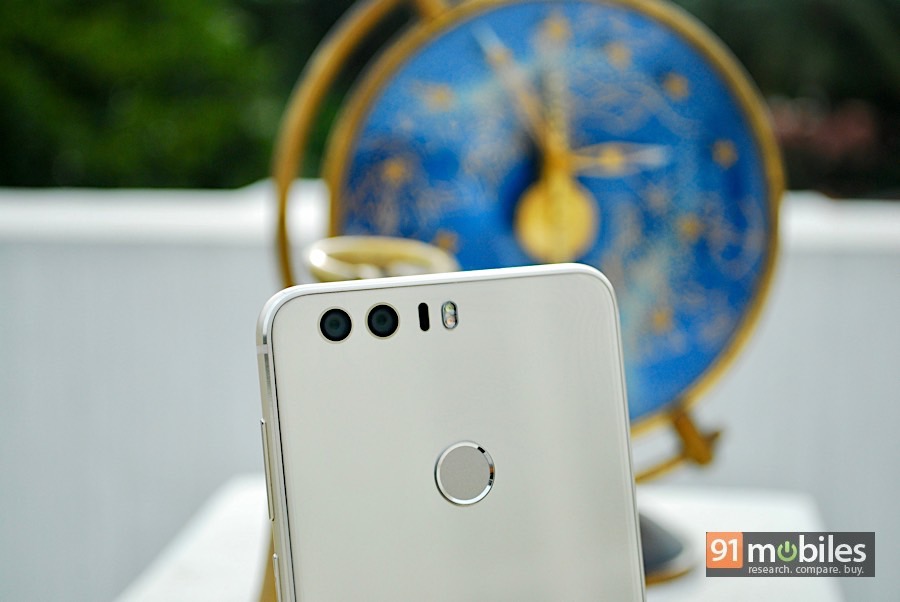
The Honor 8’s mainstay is its cameras, and interestingly, it uses the same hardware found on the Huawei P9. So you get twin 12MP sensors with f/2.2 aperture. One of the sensors is RGB to capture colour, while the other is monochrome to capture light, detail and contrast. Like the P9, snapping a photo with the rear camera results in both snappers taking an image simultaneously and providing a composite result. The main difference between the Honor 8 and P9 cameras is that the former doesn’t come with Leica branding, and as a result, you don’t get Leica’s film modes of Standard, Vivid and Smooth colours. But perhaps the biggest disappointment with the Honor 8’s cameras is the lack of a dedicated monochrome mode to take advantage of the standalone sensor. The Huawei P9 managed some stunning black and white shots, and while you can achieve this while using one of the mono filters available in the Honor 8’s camera app, it’s not the same.
The camera app is simple, with the viewfinder peppered with shortcuts like the flash toggles, filters and video mode. You’ll also find the depth of field mode here, which like the Huawei P9, artificially creates a bokeh effect by blurring the background. We found the results from this to be quite artificial though.
Swiping to the right brings up the various shooting modes, including Beauty, Beauty Video, Pro Photo, Pro Video, Good Food, Panorama, HDR, Night Shot, Light Painting, Time Lapse, Slow-mo, Watermark, Audio note and Document scan. A swipe to the left will show you settings including options like grids, object tracking and smile detection.
The Honor 8’s cameras are very good, outputting sharp, detailed image with good contrast and low noise. Close ups are particularly good, and landscape shots display good dynamic range too. Low light shots are low on noise with colours visible, but the Honor 8’s dedicated night shot mode requires a tripod to work well.
Here are some image samples taken with the Honor 8’s primary camera. You can also check out our Honor 8 camera review for more details.
Performance: runs fast, runs hot
CPU: Quad core, 2.3 GHz + Quad cor…GPU: Mali-T880 MP4RAM: 4 GBMemory: 32 GB + Up to 128 GBSIM Slots: Single SIM , GSMBattery: 3000 mAH
CPU: Quad core, 2.3 GHz + Quad cor… GPU: Mali-T880 MP4 RAM: 4 GB Memory: 32 GB + Up to 128 GB SIM Slots: Single SIM , GSM Battery: 3000 mAH |
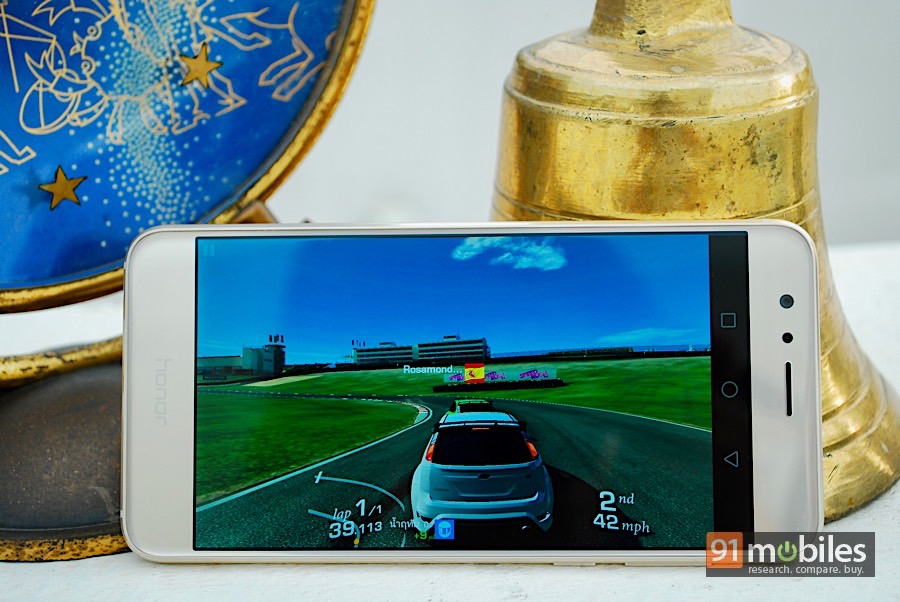
The Honor 8 is powered by Huawei’s own Kirin 950 SoC, an octa-core chipset considering of two quad-core clusters clocked at 2.3GHz and 1.8GHz respectively. This is the same processor seen on the flagship Mate 8. It’s paired with 4GB of LPDDR4 RAM. The smartphone also features an always-on i5 co-processor, which collects the data from various sensors, and is responsible for step counting in the Health app and speech recognition for the voice controls. It’s capable of performing tasks even when the smartphone is asleep, thereby reducing power consumption.
In terms of everyday performance, the Honor 8 is a powerful and smooth smartphone. There were no untoward freezes or lags that we encountered, although we did feel that the Huawei P9 was a zippier device. You should be able to play most games on the Honor 8, and the few titles we tried like Badland 2 and Real Racing 3 played without a hitch. Unfortunately the smartphone tends to heat up quite a bit while gaming, and we found the phone burning up within a few minutes of a game. It’s the same case with the use of the camera.
In terms of storage, you get 32GB of inbuilt memory, out of which about 22.5GB was available out of the box. You can top up the storage by an additional 128GB via microSD.
Huawei has always featured top-notch fingerprint sensors, and the one on the Honor 8 is no different. It unlocks the smartphone in a jiffy from sleep, even with wet hands.
The battery on the Honor 8 is a 3,000mAh unit, and in our battery drain test, it lasted for 9 hours and 8 minutes before running out of juice. The real life usage was also very impressive, and we routinely got between four to five hours of screen on time. This included calls, use of social networks, the camera and some streaming on Netflix, with a mix of both Wi-Fi and data. EMUI’s battery saver system will alert you if you have apps draining power in the background, which is useful. You can choose from various battery saving and optimising features, but the most interesting is the ROG power saving, which lowers the display resolution to 720p to save power. We saw this feature first with the Honor 6, and it’s a great way to save power without compromising on your usage. The Honor 8 unit we had shipped with a 9V/2A fast charger, which charged the device from 0 to 100 percent in 1 hour and 26 minutes. Unfortunately the retail units in India will ship with a standard 5V/2A charger, so if you want fast charging you’ll need to purchase the charger separately
In terms of connectivity, the Honor 8 offers dual-band Wi-Fi 802.11ac with an automatic switchover, Wi-Fi hotspot for up to eight devices, Bluetooth 4.2, NFC, an IR blaster and USB OTG. Unfortunately, the Honor 8 doesn’t support VoLTE in India, and we found that Reliance Jio didn’t work well even for regular 4G data on the phone. Honor says that it has plans to bring VoLTE support through an OTA update in the future, but there’s no concrete timeline on this.
Verdict
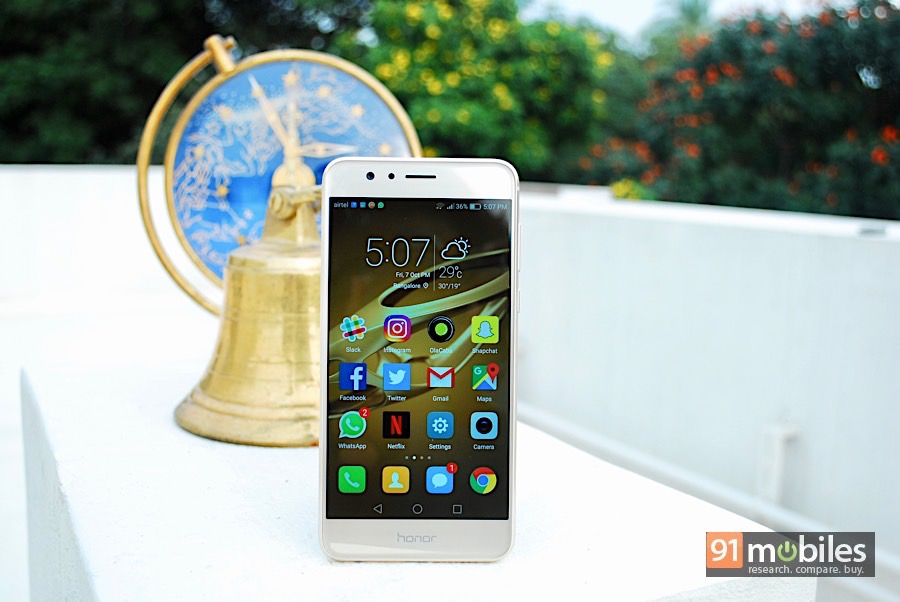
Huawei has done a lot of things right with the Honor 8, and among these is the design, which is among the best we’ve seen on a phone in the mid-range segment. The fingerprint sensor / Smart Key implementation is also a clever implementation, and we found it quite useful to quickly access apps and actions like a screenshot. The performance of the smartphone is smooth for the most part, barring the heating up while gaming, and the battery life is very good too. There are a few key areas where the Honor 8 fails though, and among these is the lack of VoLTE. While we have been told that this could be available as a future update, to not have the functionality out of the box is just inexcusable, especially considering the waves that Reliance Jio is making. This, in addition to the lack of dual-SIM is a big blow, given that the use of two SIM cards is almost a mandate in India, at least on budget and mid-range phones.
All things considered, the price of the Honor 8 at Rs 29,999 is very much on the higher side, with that price band being dominated by the OnePlus 3 (review), which in our opinion is the best option in that segment currently. You have plenty of capable devices priced much lower as well, including the ASUS ZenFone 3 (review) and Lenovo Z2 Plus (first impressions). Had the Honor 8 been priced below Rs 24,000, it would still be a competitive product, but as it stands, it’s a hard sell.
Editor’s rating: 3.5 / 5
Pros:
- Gorgeous design
- Good cameras
- Day-long battery life
- Smart Key implementation is useful
Cons:
- No VoLTE support
- No dual-SIM
- Fast charger not included
- Expensive











































